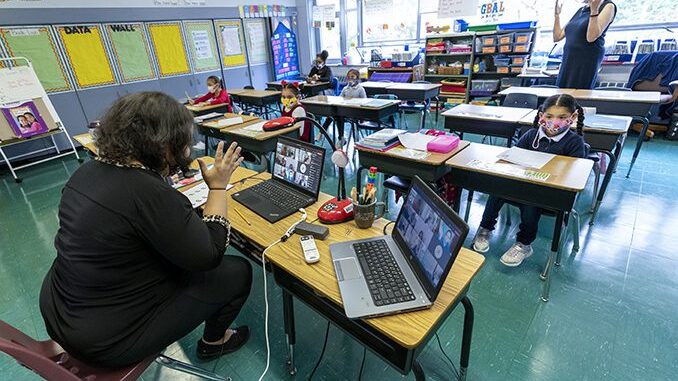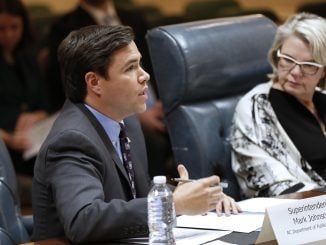
RALEIGH — Pandemic learning loss in the state’s and nation’s public schools has dominated the headlines, but another set of students have also suffered devastating effects. Students with learning disabilities have seen a steep decline in academic performance and related behavioral issues as a result of remote instruction used during pandemic school closures.
Last month, the state’s top education officials testified in front of a legislative committee about the impact of the pandemic on public education and the associated student learning loss. The report given to lawmakers was also presented this month to the N.C. State Board of Education and included data showing sizeable drops across all grade levels for students with disabilities.
Brenda Brown, a certified educational therapist with a private practice in the Charlotte area, tells North State Journal her practice has been overwhelmed with students with certain learning disabilities and that her practice is not the only one seeing a flood of cases.
Brown is licensed through the National Institute for Learning Development, which is accredited by the International Dyslexia Association. She holds a master’s degree in Reading, Language, and Literacy.
“At the regional conference I attended in February, I found out that some of the larger Charlotte private schools that have programs are exploding as well,” Brown said in an email to North State Journal. “They are unable to serve all the students and have waiting lists and are actively trying to hire more educational therapists.”
Brown said there are many students who have been pulled from public school to attend private schools and that influx has overloaded their programs.
“One school in Huntersville and another in South Charlotte were hiring therapists and had waiting lists for therapy students; both are K-12 schools,” said Brown. “The therapists were trying to make accommodations to the therapy programs that usually aren’t implemented just to serve more students.”
Brown added “This is a long term problem that just adding a session of summer school is not going to alleviate.”
Having attended both the national and regional conferences given by the National Institute for Learning Development (NILD), Brown said there was a lot of discussion about the trends with students over the last two years in particular.
“Our students have varying challenges, such as SLD (specific learning disabilities), autism, ADHD, and other lesser known diagnoses such as fragile X or XYY syndrome,” said Brown. “There is a definite trend since 2020 of learning loss and regression, particularly in the area of language and reading compared to previous years.”
The learning loss and regression issues don’t end there, however. According to Brown there is also a higher level of frustration among the students as well that ties into schools deferring to remote instruction methods.
“The International Dyslexia Association recommends that students with learning disabilities be taught using a multi-sensory approach,” Brown said. “Having instruction via a single mode, such as online, not only frustrated students, but actually caused them to regress.”
Brown said she has students who have commented that they never wanted to use Zoom again because they just can’t learn that way.
“I personally have observed learning loss of up to two grade levels with students during the time that schools were online,” said Brown. “These students with an IEP were already at least one grade level behind.”
Brown went on to detail one student who started therapy with her in August who was four grade levels behind. That student was pulled from public school and is now being homeschooled and with therapy. Brown reported that student has already gained two grade levels since therapy began.
“There are resources to help these students such as individualized educational therapy. Most parents don’t have sufficient funds to pay for these outside resources that their children desperately need,” said Brown. “The ESA+ program provides much needed funds for students with learning disabilities who don’t attend public schools. I was so glad to see the ESA+ program receive extra funding, and some students were able to begin this semester instead of waiting until fall.”
ESA stands for Education Savings Account. The ESA+ program provides scholarships of up to $9,000 a year for eligible expenses related to educating a child with a disability in a participating nonpublic school. The ESA+ program can provide up to $17,000 a year for students with certain designated disabilities.
Republicans first created the ESA program through budget appropriations in 2017, and the programs went into effect during the 2018-19 school year. Changes were made to the ESA program in 2021 under the Republican leadership at the General Assembly that consolidated Special Education Scholarships for Students with Disabilities and Personal Education Savings Accounts as the ESA+ program.
Brown commented that she would love to see the legislature implement a qualification process with the ESA+ program.
“Right now, it is so difficult to get IEPs (individualized education programs) for students who are not currently attending public schools,” Brown said. “This is due to the large number of students who need IEPs due to the shutdown of schools. If students could qualify by having a diagnosis via a psychological evaluation, more students who have never attended public schools would qualify.”
Brown noted that larger school systems are not very accommodating to private school and homeschooled students who are seeking an IEP to qualify for ESA+.
She explained that a psychological evaluation provides the needed data to determine if a disability exists while the IEP lays out the plan for improvement. Brown also said the IEP is not needed for the parent to choose resources such as occupational therapy, educational therapy, or tutoring, but that only a diagnosis of the disability is necessary and that “removing this hurdle” would allow many more students to qualify.
“Having these students be served outside the public schools also takes a huge burden off public schools,” Brown said. “Those with learning disabilities often don’t thrive in public schools for a variety of reasons. Giving parents these funds that would normally follow the student if they were in public schools allows students to be able to find the best fit to help the child succeed.”
Brown added that “The one thing that we have learned from functional MRIs is that the brain is malleable, IQ is not fixed, and those students can overcome these disabilities and thrive if given the right resources.”



